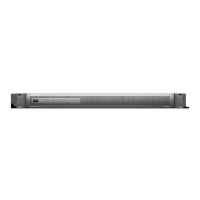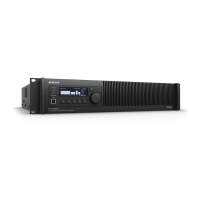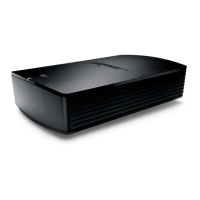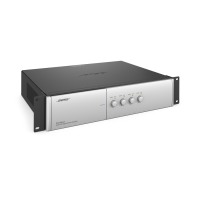84
TEST PROCEDURE
3.2 Connect 32 Ohm, 250W loads to the channel 1 - 4 outputs.
3.3 Apply a 1 kHz, -19.3 dBV input to the channel 1 - 4 inputs.
3.4 Measure the output level at the channel 1 - 4 outputs. It should be +11 dBV +1 dBV.
3.5 Set the SENSITIVITY switch to the 4 dBu position.
3.6 Apply a 1 kHz, -19.3 dBV input to the channel 1 - 4 inputs.
3.7 Measure the output level at the channel 1 - 4 outputs. It should be +19 dBV +1 dBV.
4. THD+N Test
4.1 Set the Output 1 - 4 DIP switches to Hi-Z mode (left). Set the GLOBAL OUT DIP switch to 100V
(right). Set the SENSITIVITY DIP switch to 4 dBu (left).
4.2 Connect 32 Ohm, 250W loads to the channel 1 - 4 outputs.
4.3 Apply a 1 kHz, -19.3 dBV input to the channel 1 - 4 inputs.
4.4 Measure the output level at the channel 1 - 4 outputs. Adjust the input level to attain an output of
100W from both channels.
4.5 Measure the THD+N level at the channel 1 - 4 outputs. It should be < 0.1%.
5. Frequency Response and Noise Test
5.1 Set the Output 1 and 2 DIP switches to Low-Z mode (right). Set the GLOBAL OUT DIP switch to 70V
(left). Set the SENSITIVITY DIP switch to 4 dBu (left).
5.2 Connect 4 Ohm, 250W loads to the channel 1 and 2 outputs.
5.3 Apply a 1 kHz, -19.3 dBV input to the channel 1 - 4 inputs.
5.4 Measure the output level at the channel 1 - 4 outputs. Decrease the input level to attain an output of
1W from all channels. Change the dB meter scale to dBr. Reference a dB meter to the output level.
5.5 Change the input frequency to 20 Hz. Measure the output level. It should be 0 dBr +/- 1.0 dB.
5.6 Change the input frequency to 20 kHz. Measure the output level. It should be 0 dBr +/- 1.0 dB.
5.7 Turn off the signal generator.
5.8 Set the Output 1 - 4 DIP switches to Hi-Z mode (left). Set the GLOBAL OUT DIP switch to 100V
(right).
5.9 Measure the output noise level using a 20 kHz lter and A-weighting. It should be < -57 dBV for all
inputs.
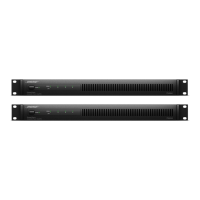
